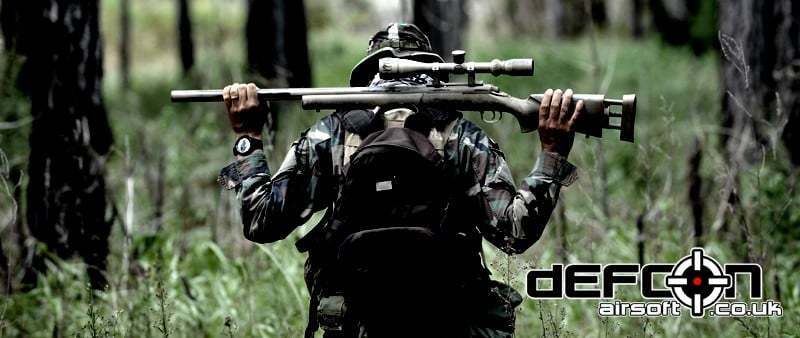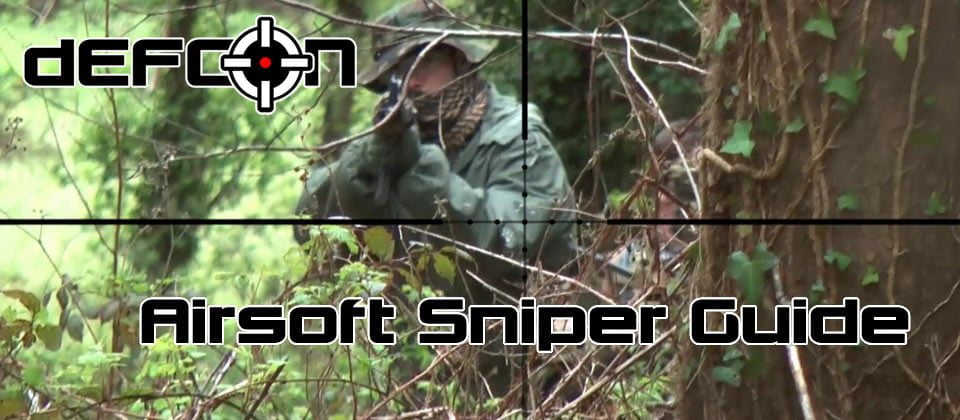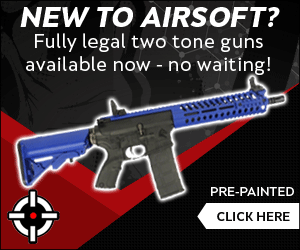So you’ve watched all of Novritsch’s videos on YouTube – followed Kicking Mustangs ‘sneaking and sniping’ exploits and have got the sniper bug. Here you’ll find all kinds of helpful information that will hopefully help you become an even better airsoft sniper. After all, snipers are supposed to outlast the enemy during combat, right? How can a sniper do that if he/she is constantly being spotted and is clueless on how to act and react on the battle-field? From how to choose a ghillie suit to how to take down an entire enemy squad, we’ve got you covered!
Sections:
Airsoft Sniper Gear
Airsoft Sniper BBs
Sniper Rifle Scopes
Sniper Ghillie Suit
Choosing an Airsoft Sniper Rifle
Airsoft Sniper Tactics
Sniper Spotter Tactics
The Sniper Team
Sniper Enemy Squad Take-Down
Airsoft Sniper Gear
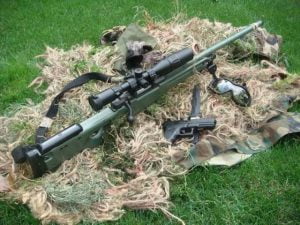 One very important thing to take into consideration is what type of gear you’ll want to take into a skirmish.
One very important thing to take into consideration is what type of gear you’ll want to take into a skirmish.
It’s vital to determine this before actually going to the site where you and the rest of the players meet.
Try to keep it as functional as possible, you don’t want to get slowed down by heavy unnecessary stuff.
Some things to take into consideration:
How many opponents:
Knowing how many opponents will be present will help determine how much ammo will be needed and how long the average game will take.
What type of environment you’ll be playing in most often: If you have a standard set of woodland/desert/multi-cam/etc. BDUs, there’s not too many modifications you can do to them to match your environment. If you have more than one design, choose the one that best fits the environment you’ll be hiding in (open field, heavy brush, snow, etc.). Same goes for a ghillie suit, although the ghillie suits are designed to be modified while in your environment.
How long is the game expected to last:
If you’re playing standard elimination style play with an average of 10-20 players, the skirmish typically won’t last much longer than 30-60 minutes. For milsim and various other types of skirmishes, the games could last much longer. This could mean, again, more ammo needed, but also a cold beverage (water) might be a good idea. A camelbak (or similar) hydration system might be needed. Because temperatures can reach dangerous highs, especially in a ghillie suit, it’s important to stay hydrated. Dehydration is not only dangerous to your health, but effects your ability to focus your thoughts and your eyes – rendering you useless to your team.
Is there a chance for close quarter fighting?
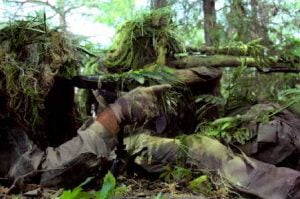 In many types of skirmishes, especially milsim, there are times when infiltrating or protecting a building or small group of buildings is part of the objectives. Also, when playing in woodland areas there are places where vegetation can be very dense.
In many types of skirmishes, especially milsim, there are times when infiltrating or protecting a building or small group of buildings is part of the objectives. Also, when playing in woodland areas there are places where vegetation can be very dense.
In these situations an opponent can appear very unexpectantly, and very close to you. To spare your rifle ammo, to spare the opponent from getting shot with a 6mm BB at 500 feet per second from twenty feet away (which would be against the site rules engagement distance for high power rifles), and in case rapid fire is needed for fighting or retreating, a sidearm might be needed. A sidearm can prove to be a nuisance on the field, getting in the way while crawling and getting caught on brush during standard movement, so it’s important to know whether or not one will be needed during the skirmish. It could also mean a second weight of BB will need to be taken along.
The most important thing to remember is to only take what you needed, nothing more, nothing less. As a sniper you must remain light on your feet and focused on the objective. You won’t be able to do this if you’re weighed down by too much gear and/or the wrong type of gear.
Standard Airsoft Sniper Equipment:
Primary Weapon: Sniper Rifle
Price: £80-£500+
Gun Camo
Price: £20-£60
Scope
Price: £30-£120+
Secondary Weapon: Pistol
Price: £30-£250
Sidearm Leg Holster
Price: £10-£40
Full body ghillie suit (or set of BDUs)
Price: £50-£150
Fingerless Gloves
Price: £10-£25
Goggles/Glasses
Price: £5-£140
Hydration System
Price: £25-£75
Optional: Sniper Rifle Aimcam Package (If you are looking to make your own scope cam gameplay videos these are perfect)
Price: £170
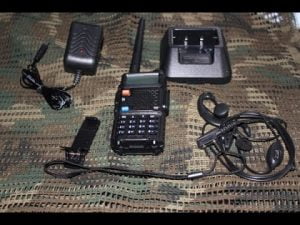 Another optional piece of equipment that could prove to be handy is a two-way radio. Whether you choose to use it with your spotter (if you have one) or the rest of your team, having one on you could be very useful when trying to locate your team, enemy, and/or objective points.
Another optional piece of equipment that could prove to be handy is a two-way radio. Whether you choose to use it with your spotter (if you have one) or the rest of your team, having one on you could be very useful when trying to locate your team, enemy, and/or objective points.
When choosing one, try to pick one that eliminates static, has a battery meter, is weather resistant, and has an effective range of at least 2 miles. It might also come in VERY handy to use a handsfree piece along with your 2-way.
Airsoft Sniper BBs
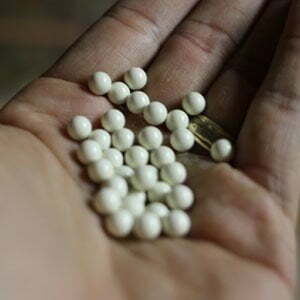 What size BB is best for my gun? Does it matter what brand it is?
What size BB is best for my gun? Does it matter what brand it is?
For the experienced airsoft sniper or designated marksman, you may already know what ammo make, model, and size is best for your particular gun.
For the new sniper, this choice is very important! There are many factors that come in to play when it comes to being a successful sniper and picking the right ammo for your gun is one of them.
There are many common misconceptions about choosing a BB. For example, it is a well spread rumor that the heavier the BB, the shorter your effective range. This isn’t the case. In fact, the key to your success is finding the heaviest BB your gun can handle and sticking with it.
You can have the nicest rifle with the most advanced upgrades available for it, but your gun is only going to be as good as the ammo you’re using!
First let’s go over the various BB sizes:
.12g – Very lightweight. Too easily affected by weather and hop-up. NOT RECOMMENDED for any gun!
.15g – A little heavier than the .12g, but still way too light for any airsoft sniper rifle.
.20g – A well-made .2g will produce acceptable results, but still not recommended (unless for low-end guns)
.23g – Can be used with good results in an airsoft rifle, but why not go for a .25g BB?
.25g – Now we’re talking. This weight of BBs is the lowest recommended weight for a quality airsoft rifle.
.28g – Welcome to the heavy-weights. These are for mid-grade (or upgraded guns) to high-grade rifles but for sniper rifles you’re still gonna need heavier.
.30g+ – This is what we need for sniping territory. The most popular weight for snipers is 0.40g BBs but the truth is there’s no clear cut way for me to tell you exactly which type of BB would be best for you and your gun.
The type of BB you should choose depends on many factors like what gun you’ll be using, what (if any) parts are upgraded, what is the weather like most often where you play, and what distances are you most often shooting from, just to name a few. The best advice is to buy a few small bags of the recommended brands and sizes I mentioned above, and try them out yourself! Sight your scope in and adjust your hop-up with each brand and size of BB, making sure to fire off many rounds with each to get a clear idea of the individual performances.
Find which BB works best with your needs and your gun’s abilities and go with it! This process takes a small investment and possibly a good bit of time, but it’s well worth it. Having the right BB for you and your gun can make a serious difference in your game.
Sniper Rifle Scopes
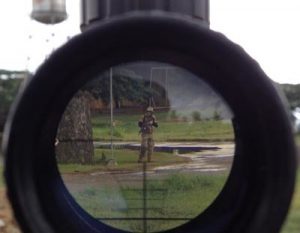 Another piece of equipment you’ll need to take into consideration is picking the right scope and there are some great affordable scopes which work well. Considering the ranges that you’ll be engaging it and that you are ultimately shooting small plastic balls, you don’t need to go for a huge scope with 24 x zoom. Anything between 3-9 is more than adequate. The higher magnification levels are good for spotting, but certainly not tracking your BB.
Another piece of equipment you’ll need to take into consideration is picking the right scope and there are some great affordable scopes which work well. Considering the ranges that you’ll be engaging it and that you are ultimately shooting small plastic balls, you don’t need to go for a huge scope with 24 x zoom. Anything between 3-9 is more than adequate. The higher magnification levels are good for spotting, but certainly not tracking your BB.
It’s important to take into consideration the range and accuracy of your airsoft rifle. We recommend an airsoft sniper rifle scope with relatively low magnifcation (3-5X magnfication). If you don’t know what these numbers mean, I’ll explain quickly.
Let’s use a 4X32 powered scope. The first number (4) represents the power of the magnification. The object being viewed appears to be 4 times closer than it would be if viewed without the scope. It’s a common misconception to think that the higher the magnification, the better off you’ll be. This isn’t necessarily true. For airsoft, a 3x or 4x magnification scope is perfect.
The second number is the diameter of the front lens (in millimeters). The larger the lens, the more light that enters the scope, and thus the brighter the image.
If you see a scope that says 3-9X32, for example, the 3-9 simply means you can adjust the magnification from 3 to 9 times magnification, and the front lens is 32mm.
Sniper Ghillie Suit
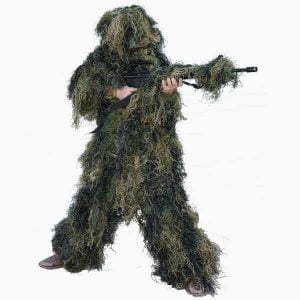 There are a few things you’ll need to consider here. A few examples include whether or not buying/constructing one is in your budget, what type of terrain will you be playing in most often, what type of sniper are you most often (highly mobile, stationary, prone position, etc.), what are the average temperatures of where you play etc.
There are a few things you’ll need to consider here. A few examples include whether or not buying/constructing one is in your budget, what type of terrain will you be playing in most often, what type of sniper are you most often (highly mobile, stationary, prone position, etc.), what are the average temperatures of where you play etc.
We have sniper ghillie suits here starting at around £59. Some people choose to buy a ghillie suit instead of making one but if you make one still can cost upwards of £40 for mid-grade ghillie suits. For the very best Ghillie suits take a loock at the Kicking Mustang Concealment System here.
If you would prefer to make a suit you’ll find it’s very rewarding to build your own suit and great because you customise it to compliment your exact needs.
There are already so many good instructions floating around on the web if you do a quick search but there is a good guide here www.wikihow.com/Make-a-Ghillie-Suit.
Remember that there are many ways to build a ghillie suit and all can either end in disaster, or a professional-quality ghillie suit.
The difference between a ghillie suit and a ghillie poncho is exactly how you’d picture it. A poncho is typically an one piece (rain) poncho-like garment. A poncho looks VERY similar to a suit, but they do have their differences. Ghillie suits are comprised of 2+ pieces, always including one piece that covers your torso and arms, the other that covers your legs. The poncho style of ghillie is just like a rain-poncho: A person slides the one piece over them. Ponchos usually have a hood and arm sleeves.
Make sure that the Ghillie you buy is adaptable for your individual requirements. For example, snipers will often be laying down, unlike a hunter. This means an open front ghillie suit may be preferrred. Just make sure you shop around and find one that suits your needs, and your wallet.
No matter what you decide to purchase, there are four big things you need to remember:
#1 – Find an even balance between quality and price.
Although finding the lowest prices is a good way to start when choosing to buy a suit, poncho, or kit, if the materials contained within them are cheaply manufactured, your suit will not last long and you’ll be buying another one before you know it.
#2 – Safety First!
Ghillie suits are highly-flammable by nature so it’s important to either buy fire-retardant treatment to cover your suit in, or purchase a suit not made out of the flammable burlap, but a synthetic, already fire retardant material. You’d be surprised how quickly these suits can go up in flames. I highly doubt you’d like to be a human torch.
#3 – Make sure you stay hydrated.
The temperature inside a ghillie suit in summer can quickly soar. Not only are these temperatures very uncomfortable, but potentially dangerous. Drink plenty of water before, during, and after games.
#4 – Customize your ghillie to suit your needs.
Ghillies come in all styles, shapes and sizes. Make sure the one you choose is the one that fits your needs the most. For example, the sniper that is often on the move may prefer a suit that has an open front, is lightweight, and one that doesn’t have strand after strand of burlap constantly covering his/her eyes during movement!
Choosing an Airsoft Sniper Rifle
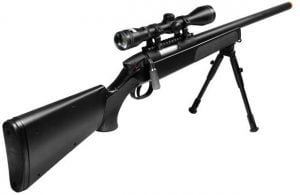 Although choosing a quality sniper rifle is important, it doesn’t necessarily make or break a sniper. There are many factors that determine the success of a sniper, the rifle is just one of them. This is the reason so many people on airsoft forums hate to hear “which gun should I buy?” from people just getting into airsoft.
Although choosing a quality sniper rifle is important, it doesn’t necessarily make or break a sniper. There are many factors that determine the success of a sniper, the rifle is just one of them. This is the reason so many people on airsoft forums hate to hear “which gun should I buy?” from people just getting into airsoft.
The fact is that no one can decide that but you. You know your skills, weaknesses, and the amount of money you’re able and willing to spend.
Here are a few key tips:
Pick a gun that you’ve either used before or a friend has used before.
If nothing else, search around on the internet for user reviews of the specific gun you’re interested in. Make sure your final opinion of the gun is based on several different reviews on different sites – don’t let just one or two make up your mind. And never, EVER impulse buy!
Pay at least £100 for a sniper rifle.
I know I said earlier that how much money you spend on a gun doesn’t make a sniper, but you have to draw the line somewhere. A cheap plastic gun won’t last long and won’t give you a consistent shot. £100 is the VERY least you should spend on a brand-new rifle. Many people will spend several hundred pounds on the rifle and its upgrades.
Go for consistency and accuracy over power.
Make sure the shots are hitting within near vicinities each and every shot. Every shot counts in sniping so it’s vital to know where your bb is going before the shot is made.
“Which sniper rifle should I buy?” – This is an extremely popular question, and one that gets answered often, especially on airsoft forums. A good FPS for a sniper rifle is anywhere between 400-500 FPS, depending on your environment and field rules. Do not be confused by guns online that offer an £80 gun that’s firing 500 FPS. FPS means nothing if your gun is crap and fires inaccurately.
Here are some good choices of airsoft sniper rifles. Which is best all depends on you, your environment, your gear, your budget, etc. etc. Obviously a Tokyo Marui VSR G-SPEC will be better built than a cheap VSR clone even though to the untrained eye it may look similar. However, maybe you don’t have the £££’s to spend on the gun and the needed upgrades. It all depends on YOU. I will say this though, for someone looking to get into sniping on a budget – the following are all great rifles to get started with:
JG Bar-10:
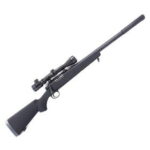 The JG Bar-10 is amazing, especially for it’s price tag.
The JG Bar-10 is amazing, especially for it’s price tag.
It looks and feels great, and gives you great performance out of box. One of the famous attributes of this gun is it’s ability to be easily upgraded.
It can be made into a rifle firing 500fps with only a few “tweaks” to the internals which can be done FREE (except maybe for a tightbore barrel).
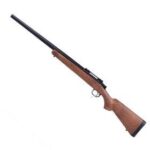 Cyma CM701:
Cyma CM701:
The Cyma CM701 is another nice VSR clone and comes in at an even more competitive price than the JG-Bar-10. While the CM701 is a great out of the box starter rifle, we think it is worth paying a little more and getting the JG – the rubberised texture on the body just feels better quality.
Classic Army M24 LTR:
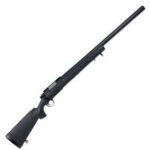 The new kid on the block, reviews for this seems like it’s going to be the one to beat at a fantastic price. The Classic Army M24 Light Tactical Rifle “LTR” is a high performance bolt action sniper rifle made with a high quality nylon fiber polymer stock, full metal trigger box, and full metal barrel.
The new kid on the block, reviews for this seems like it’s going to be the one to beat at a fantastic price. The Classic Army M24 Light Tactical Rifle “LTR” is a high performance bolt action sniper rifle made with a high quality nylon fiber polymer stock, full metal trigger box, and full metal barrel.
The M24 LTR is Tokyo Marui VSR10 compatible, making it very popular for it’s upgradeable design, and after-market parts availability. The piston included with the M24 is a 90 degree, along with strong sears already installed. Overall, it’s an amazing sniper rifle!
Ares Amoeba Striker:
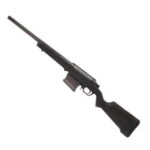 I thought I’d go ahead and throw out one of my favourite sniper rifles – the Ares Amoeba Striker. It has a great physical feel to it and will impress anyone and everyone who lays their eyes upon it. It’s well balanced and has strong enough internals to simply throw in a stronger spring for higher FPS, which means you’re ready to go for fairly cheap upgrades! It’s of course going to cost a little more than a JG Bar-10 or Cyma VSR, but it’s well worth it if you have the money, and it works out far cheaper than an upgraded TM VSR of a similar power.
I thought I’d go ahead and throw out one of my favourite sniper rifles – the Ares Amoeba Striker. It has a great physical feel to it and will impress anyone and everyone who lays their eyes upon it. It’s well balanced and has strong enough internals to simply throw in a stronger spring for higher FPS, which means you’re ready to go for fairly cheap upgrades! It’s of course going to cost a little more than a JG Bar-10 or Cyma VSR, but it’s well worth it if you have the money, and it works out far cheaper than an upgraded TM VSR of a similar power.
Tokyo Marui VSR 10:
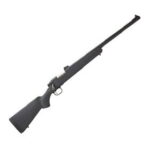 Tokyo Marui is one of the most advanced airsoft manufacturers out there, and therefore one of the most well-known as well. They pretty much set the standard for all guns, every model available. The VSR-10 Pro is a great rifle made by TM. It feels great, shoots great, pretty much gives you everything you’d expect from a Tokyo Marui replica… including low FPS. Firing at a stock FPS of around 285, we’re not talking great specs here. However, throw in a few upgrades and you have yourself a top-of-the-line sniper rifle. You’ll still be able to use it un-upgraded, but I honestly wouldn’t recommend going like that for long. Then again, I’d recommend getting the JG bar-10 for less and throwing the extra money into that.
Tokyo Marui is one of the most advanced airsoft manufacturers out there, and therefore one of the most well-known as well. They pretty much set the standard for all guns, every model available. The VSR-10 Pro is a great rifle made by TM. It feels great, shoots great, pretty much gives you everything you’d expect from a Tokyo Marui replica… including low FPS. Firing at a stock FPS of around 285, we’re not talking great specs here. However, throw in a few upgrades and you have yourself a top-of-the-line sniper rifle. You’ll still be able to use it un-upgraded, but I honestly wouldn’t recommend going like that for long. Then again, I’d recommend getting the JG bar-10 for less and throwing the extra money into that.
WELL L96:
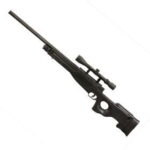 This is a very popular gun among airsofters because it offers all the specs and looks they desire, but still comes with a fairly low price tag. The WELL version even comes with a scope. This gun is very impressive for its price, and can take some serious abuse with its durable ABS plastic body and metal scope rail, outer barrel, trigger, bolt, etc. It has somewhat of a heavy pull to the bolt, but it makes up for it with a 435 average FPS. Upgrades can get costly, but if you’re on a budget and looking for a good looking gun that you don’t plan on putting a lot of upgrades into, then this gun will suit your needs just fine.
This is a very popular gun among airsofters because it offers all the specs and looks they desire, but still comes with a fairly low price tag. The WELL version even comes with a scope. This gun is very impressive for its price, and can take some serious abuse with its durable ABS plastic body and metal scope rail, outer barrel, trigger, bolt, etc. It has somewhat of a heavy pull to the bolt, but it makes up for it with a 435 average FPS. Upgrades can get costly, but if you’re on a budget and looking for a good looking gun that you don’t plan on putting a lot of upgrades into, then this gun will suit your needs just fine.
Just Like In The Movies?
A lot of airsofters start off wanting to get into sniping because they remember back to watching movies like Jack Reacher and American Sniper and see it as this exciting role where they’re making amazing long-distanced shots on “high-level” targets (presidents, VIPs, etc.). This just simply isn’t the case. Most often they will be in the action, but not nearly as much as an AEG carrier.
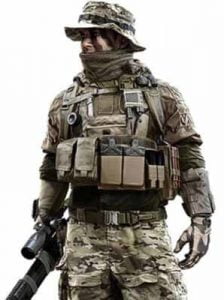 A Sniper’s main goal will typically be to give recon to its team, provide support when needed, and harass troops. Sure it can be an adrenaline rush and it’s a lot of fun, but it also takes patience, a clear mind, maturity, and skill in many different areas. That’s why I recommend to most newer players that you start off with an AEG. They’re still a blast to play with, they give you a better idea of how airsoft works, and they still have incredible ranges.
A Sniper’s main goal will typically be to give recon to its team, provide support when needed, and harass troops. Sure it can be an adrenaline rush and it’s a lot of fun, but it also takes patience, a clear mind, maturity, and skill in many different areas. That’s why I recommend to most newer players that you start off with an AEG. They’re still a blast to play with, they give you a better idea of how airsoft works, and they still have incredible ranges.
For those who are still going to purchase an airsoft sniper rifle, please remember the old adage – ‘buy cheap, buy twice’. You don’t need to spend a fortune but anything under £100 isn’t going to be great without throwing money at upgrades. And the only reason I keep it that low is because of the JG Bar-10. (It really is an incredible rifle) Other than that, don’t go out and throw down £70-£120 on a mid to low grade gun that looks great in the pictures and supposedly shoots a whopping 500 FPS. It’s a waste of your time and money. If you don’t have the patience to wait to save enough money to buy a decent gun, then I’d say you don’t have the patience enough to be a decent sniper.
So purchase a nice rifle, take care of the upgrades, keep your gun well maintained, and have fun!! Just remember every single person out there on the field has a specific and important role – no one is superior to another. So show respect to everyone equally.
Airsoft Sniper Tactics
It’s all well and good looking like a bush and carrying the most up to date kit with perfectly set up rifle, but if you’re in the wrong place at the wrong time then your no good to anybody. Being in the right place is just as important as using the right equipment.
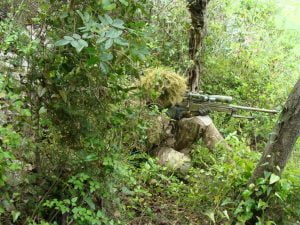 First note that you are part of a team. To win you need to work as a team with good communication before and during the game. This is essential. You want to, as best you can, deceive the opposition about your abilities. If they don’t think you are a sniper you will be more effective than if they know you are. Never form a pattern. If you find a way to attack or defend something well, it will not be long before people will predict what you will do and where you will be when you do it. An airsoft sniper can have a variety of different roles and its important to know where you fit in the bigger picture of securing the objective.
First note that you are part of a team. To win you need to work as a team with good communication before and during the game. This is essential. You want to, as best you can, deceive the opposition about your abilities. If they don’t think you are a sniper you will be more effective than if they know you are. Never form a pattern. If you find a way to attack or defend something well, it will not be long before people will predict what you will do and where you will be when you do it. An airsoft sniper can have a variety of different roles and its important to know where you fit in the bigger picture of securing the objective.
This being Airsoft, you tend to know where the opposition will be as there are a given set of boundaries they have to be within. If possible, find out as much about the area you are about to play in before you go. The type of ground, the vegetation, local teams and strengths; anything that you might find useful will be of great help. A lot of the information can be found on team websites. Many list their members, what they look like, and sometimes their tactics and equipment. Check if they have any other snipers, as most probably that will be your largest foe.
Now that you have the basic info you need make sure you are on the same page as your team. More often than not I am shot by my own team for one reason or another (normally did not think I got where I was that fast), so let your team know who you are, if you’re wearing a ghillie, what it looks like and where you will be going. At this point I have to say snipers normally are more experienced players though not always the case, and have been in teams or a self set up sniper team.
You have to decide if you’re going to work alone, looking at the pro’s and con’s, or are you going to work with another? It is possible to work in sniper teams and can achieve good success.
Working alone.
In Airsoft I would say this is a viable option (though still working with a team). It is far easier for one person to move unnoticed than it is for more than one. Unfortunately it does mean that you have no back up, nobody to help you pull out if need be, and, if you’re using a single shot, no room for error.
If working with a partner you have more of a chance of completing your designated task (not necessarily the overall objective) easier. Also, I have to say, it is easier to work with the same people so you learn to work together knowing their strength and weaknesses as so to overcome them.
Working in a team.
When working in a team you have the advantage of larger firepower though a possibility of them giving you away.
To attack an object you have to look at what you are using, who is in your team, and what they will be doing, as well as who you’re attacking. Taking everything into account, you are supposed to work out what is the best way for you to attack them.
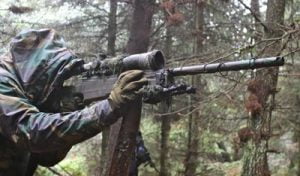 It largely depends on what you are to do. If it’s to take an object you are more likely to cover your teammates taking out snipers and others that pose a threat to your team rather than storming the compound. That can be either from a distance or close up support (normally where superior camouflage comes in to good use). This depends on what you use to an extent. Not only are you there to aid your team by taking out people that cause problems but also you can be the team’s eyes.
It largely depends on what you are to do. If it’s to take an object you are more likely to cover your teammates taking out snipers and others that pose a threat to your team rather than storming the compound. That can be either from a distance or close up support (normally where superior camouflage comes in to good use). This depends on what you use to an extent. Not only are you there to aid your team by taking out people that cause problems but also you can be the team’s eyes.
I have played a few games where I have just spotted for the team, crawled in close and radioed where people are. A lot of people won’t do this because they want to fire their weapon and nothing more. You’re supposed to be working as a team, not as Rambo. I doubt you are a sniper if this is how you play.
Defence is slightly harder. You will probably have to defend an object from being captured rather than prevent a person being shot. You will need to find an advantage point which is within the boundaries and gives you cover, both hard and soft, so you’re not too obvious, yet you’re still able to defend the object.
Whether it is defending the object from within the object or from its outer boundaries, there is no answer to how is the best way to defend it. It depends on the object, how well you can disappear, and your advantage point. It is by far the hardest form of skirmishing for me anyhow.
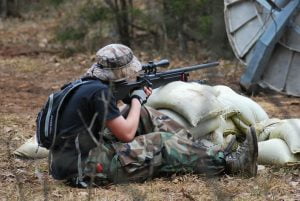 All rules of never firing in one place can and some times have to be thrown in to the wind as moving is not always possible. It’s probably best to be slightly forward or to a flank and fall back than it is being on the object all the time. What I do know is that you need to prioritise. If the other team has a sniper, think where they’re likely to go and look out for them. Same with more experienced players, remove their ability to work as a team.
All rules of never firing in one place can and some times have to be thrown in to the wind as moving is not always possible. It’s probably best to be slightly forward or to a flank and fall back than it is being on the object all the time. What I do know is that you need to prioritise. If the other team has a sniper, think where they’re likely to go and look out for them. Same with more experienced players, remove their ability to work as a team.
Take out the people that are passing on your team’s positions, or the person that seams to be directing people. Remove the team’s ability to work together and you have a greater chance of defending your objective. This also applies to attacking an object, teamwork, and good communication is more likely to win a game rather than a disorganised rabble (although a good friend of mines main motto is ‘just run in and f**k sh*t up!).
It also pays to take out those that pose a direct threat to your self as well as your team, though only a threat, if they do not know you are there use it to your advantage. You will have far more of an advantage/impact if they don’t realize where you are. If your shooting at everything that moves, its not going to be long before you will be picked off with heavy amounts of fire.
If a sniper leaves the team to take out casual targets, or targets of opportunity, it isn’t long before people see them and let others know that they are there. You’re part of a team, work as one. An individual never lasts too long, especially if there is a sniper section on the other team.
I have occasionally played games where the sniper section is allowed to defend an object from behind the opposition, this is where sniping comes in to its own and is by far my preferred type of scenario. For attacking you have to be ever vigilant of the rear of the team; look for players that make their way around the back of your team.
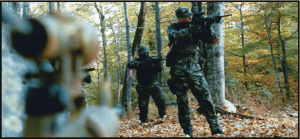 Keep an eye on them if possible. Set up ambushes for them if need be. More importantly see if they have indeed sent out a roving patrol, otherwise you’re wasting your time. Count how many there are on the other team and if you can’t see or at least account for the sniper team, assume they’re behind you or to one of your flanks. Rest assured they’re looking for you specifically.
Keep an eye on them if possible. Set up ambushes for them if need be. More importantly see if they have indeed sent out a roving patrol, otherwise you’re wasting your time. Count how many there are on the other team and if you can’t see or at least account for the sniper team, assume they’re behind you or to one of your flanks. Rest assured they’re looking for you specifically.
If you happen to be a part of the patrol, use it to your best advantage, find the other teams core element, or sniper team. Most of the time they will be engaged with the attack. Use surprise as best you can, move about a lot and attack from many different angles not to let them rest easy. Its best to attack when they’re on the attack, as they tend to be facing the opposite way and making this far easier. The less they know where/who you are the more effective you will be. I tend to find letting them walk right past you gives them more confidence that there is nobody around making them more careless of players! Use everything you can to your advantage.
Sniper Spotter Tactics
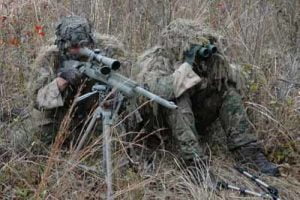 It is popular belief that snipers are the “lone wolf” of the military scene, but in the professional world of sniping it is not a one man team but a pair of two highly skilled soldiers acting as one. This section aims (no pun intended) to describe a functional spotter/sniper relationship (in the context of airsoft). Reading this should help you to understand the potential benefits from a well-trained spotter as well as help you better communicate with your spotter effectively and quietly.
It is popular belief that snipers are the “lone wolf” of the military scene, but in the professional world of sniping it is not a one man team but a pair of two highly skilled soldiers acting as one. This section aims (no pun intended) to describe a functional spotter/sniper relationship (in the context of airsoft). Reading this should help you to understand the potential benefits from a well-trained spotter as well as help you better communicate with your spotter effectively and quietly.
The spotter is there to offer continuous support for the sniper. He should be aware of the surroundings, escape routes, ally positions, all targets, and the sniper’s shots. A spotter should be able to trace the snipers shots and inform him/her on how to better his next one. Having a spotter will allow the sniper to focus solely on his shots. We will focus on these essential tactics as well as some others.
Planning is perhaps the most important step if the sniper’s mission is to be successful. When moving to a target area both the spotter and sniper should look at the area and assess where the best final firing position (FFP) would be. This must be a place that will provide concealment, cover, and the best view of the surrounding areas.
During movement to the FFP the spotter, carrying an assault rifle opposed to a sniper rifle, should take lead. Obviously the situation may force the team to act differently, but for most situations the spotter should take lead during movement phases.
Once at the FFP, the spotter should take position slightly behind and off to either side of the sniper. This will allow the spotter to better trace the sniper’s shots and facilitate easy communication.
The spotter should continuously relay important information to the sniper. Such examples would be target locations, target status (whether the sniper’s shot was a kill), and shot calls (where the sniper’s shot fell and adjustments). This is where the previously mentioned good spotter positioning comes in. A view down the length of the sniper’s weapon will allow the spotter to better trace the sniper’s shots.
Although the above relationship between a sniper and his spotter is sometimes very difficult to attain, there is no replacement for it. Much of it will come through practice/repetition. A good experienced sniper/spotter relationship WILL spell disaster for the opposing team.
The Sniper Team
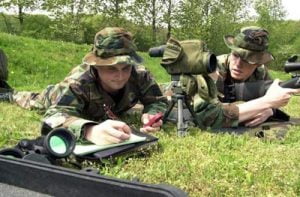 The most important thing here is a good firing position where terrain, distance and wind data is exchanged.
The most important thing here is a good firing position where terrain, distance and wind data is exchanged.
They will take turns in observing to avoid eye fatigue and they have to speak “the same language” to avoid misunderstandings.
One must remember that the kill shot is a mutual effort and the most important parts consist of the following:
* Determine the effects of weather on ballistics.
* Calculate the range to the target.
* Make necessary sight changes.
* Observe the bullet impact.
* Evaluation of the mission.
The team always stays within eye contact of one another, and they communicate mainly through signs until the shot will take place. The spotters’ role is to locate the target and “walk” the sniper to the target, the correct range and wind adjustments.
The spotter – sniper dialogue before a shot will contain:
* A warning order – call to action: given by spotter when he discovers the target. He notifies the sniper: – “Target!”
* Target location: spotter continues with telling the sniper where target is according to earlier determined references. He notifies the sniper: – “Sector A – TRP 1, left 50m!”
* Target description: distinguishing general references, simple but specific. Spotter notifies the sniper: – “Short soldier – black hat!”
* Wind call: spotter checks the wind and notifies the sniper: – “Wind right to left, XXkm/h – hold XXXm right”.
* Fire command: is given and the sniper has 3-9 seconds to take the shot. If the shot doesn’t take place a new wind call will come from the spotter.
* Shot call: the sniper tells were the round broke so that the spotter can adjust.
* Target status: status of the target and if an additional shot is needed.
* After the shot is fired. The team withdrawals back to their base of operations or to an extraction point. They will record the given data (if not already done at place of the shot) in a “kill book” were each shot and the circumstances of it is written down (time, date, location, details of target, details of conditions, etc.).
A “kill book” ensures that the shot can be correctly analyzed and maybe leave room for improvements (this is done for every shot taken – even during practise and with shots fired on the firing range). It will also help the fire team to make a better shot under similar circumstances the next time. When a safe area is reached the team evaluates the mission and looks for possible improvements.
Sniper Enemy Squad Take-Down
How to take on forces much larger than yourself.
 You’re alone, deep in enemy territory with no other mission than to cause havoc among any opposition you come across. You’ve been hand-picked by your superior to patrol about 10 acres of forest as a chance to slow down enemy advancements. You have no reinforcements available, just you and your rifle. At this moment in time you are watching over a footpath that you know some unlucky soldier will tread down any time. You wait patiently. You hear voices in the distance. You raise your rifle, click off the safety, and prepare for a shot. Around a bend about 50 meters in front of you walks a group of what you estimate to be about ten enemy soldiers armed with AEGs ready to tear you apart as soon as you make the first move. What do you do? Do you remain hidden, allowing this patrol to pass by while you wait for a somewhat weaker force to cross your path? Do you take a shot? If so, which soldier do you fire the first round at? Does it matter?
You’re alone, deep in enemy territory with no other mission than to cause havoc among any opposition you come across. You’ve been hand-picked by your superior to patrol about 10 acres of forest as a chance to slow down enemy advancements. You have no reinforcements available, just you and your rifle. At this moment in time you are watching over a footpath that you know some unlucky soldier will tread down any time. You wait patiently. You hear voices in the distance. You raise your rifle, click off the safety, and prepare for a shot. Around a bend about 50 meters in front of you walks a group of what you estimate to be about ten enemy soldiers armed with AEGs ready to tear you apart as soon as you make the first move. What do you do? Do you remain hidden, allowing this patrol to pass by while you wait for a somewhat weaker force to cross your path? Do you take a shot? If so, which soldier do you fire the first round at? Does it matter?
As a sniper your goal will usually consist of 1 of 3 things. You will be assigned to either eliminate a specific target, harass enemy troops (and I don’t mean by yelling mean comments as you run away), or provide recon for a much larger force. Whatever your detail, you’ll eventually be put in a situation where you have the opportunity to take on a force much larger than yourself.
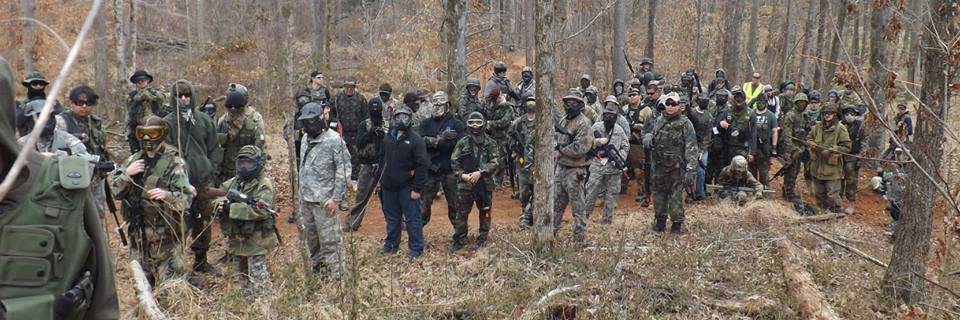 If you decide to take on a large grouping of soldiers, you’ll need to know how to properly handle yourself to avoid being overwhelmed by their weapons and rendered useless to your team. When faced against a squadron of enemy soldiers, you’ll want to pick off the closest to you. When he falls, the rest of the troops will (9 times out of 10) move away from the downed soldier, which in this case will most likely be away from you (distance is a sniper’s friend).
If you decide to take on a large grouping of soldiers, you’ll need to know how to properly handle yourself to avoid being overwhelmed by their weapons and rendered useless to your team. When faced against a squadron of enemy soldiers, you’ll want to pick off the closest to you. When he falls, the rest of the troops will (9 times out of 10) move away from the downed soldier, which in this case will most likely be away from you (distance is a sniper’s friend).
Also, take your time. Human actions/reactions are very similar in Airsoft to actual combat (in serious tournament play, at least). When that first soldier falls the rest will most likely move away from the spot, but still remain somewhat close to the victim. This is because, just like in real combat, they most likely won’t leave the wounded behind. Based on past experience, this scenario will play itself out like this:
You take out the soldier closest to you, he falls. Immediately the team opens fire (randomly) in order to suppress your fire while they take cover in nearby trees, buildings, etc. They remain close, periodically scanning their surroundings looking for the sniper, you! Depending on the rules of the game (how medical attention is delivered), a medic will be sent to aid the soldier while the remaining team members give suppressive fire on what they think is your location.
What they don’t know is that during their rush for cover, you quickly but without being noticed moved into a slightly better/different location depending on where the downed soldier is and where the remaining men/women ran for cover. As the medic sprints to get the soldier out of harms way, you take another shot, stopping the medic in his tracks.
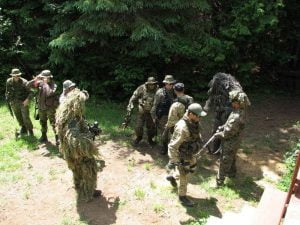 You make sure you take the shot on the medic when he/she is standing over the wounded to ensure no chance that a nearby teammate could tend to him/her and so you the targets can be easily seen since they’re grouped together. What you do now is based solely on your situation. Do you have another objective to tend to? Is the squadron large and/or close enough to, if desperate, quickly overtake your position? Do they seem to have found the general area you’re hiding in? Would keeping this squadron pinned down aid in an ongoing mission? All these are very important questions, and ones that you’ll need to ask yourself and answer very quickly! Be ready to run or hide!
You make sure you take the shot on the medic when he/she is standing over the wounded to ensure no chance that a nearby teammate could tend to him/her and so you the targets can be easily seen since they’re grouped together. What you do now is based solely on your situation. Do you have another objective to tend to? Is the squadron large and/or close enough to, if desperate, quickly overtake your position? Do they seem to have found the general area you’re hiding in? Would keeping this squadron pinned down aid in an ongoing mission? All these are very important questions, and ones that you’ll need to ask yourself and answer very quickly! Be ready to run or hide!
Remember, as a sniper, most likely your goal is to simply harass the enemy and cause confusion among the soldiers. In this scenario, you’ve done just that. There’s no need to feel like your job isn’t done till all the soldiers are downed. There would be nothing wrong with getting up and leaving to continue your work!
If you have a spotter with you, make sure you’re the one taking the shots and not him. You’re the one with the long range rifle. Him spouting out magazines of ammo would only force the enemy to turn this battle into a two-way firefight, one you’re outgunned in! Not to mention the clanking of his rounds moving throughout the gun would quickly give up your position.
The spotter’s role in this case will be to
1. Make sure the surrounding area remains safe – the pinned soldiers aren’t the only ones in the battle!
2. Give support fire if your location is found and being advanced upon.
3. Give cover fire during retreat (if needed). And finally,
4. Give you medical attention/support fire if a stray BB from their suppressive fire makes contact with you.
Whatever you do, remain calm! There’s no use in allowing your adrenaline to control your mind! Try to continually breathe smooth, consistent breaths. Keep a steady hand and focus solely on the situation at hand.
Remember “Pride ends in humiliation, where humility leads to honor.” You will miss targets from time to time. Don’t beat yourself up about it!
Learn from each and every shot you take. A missed shot should only improve your game. Perfection can never be attained, but a continuous effort to achieve your “best” must always be in effect.
Learn more about airsoft sniping on these useful sites:
AirsoftForum.com – The Sniper Rifle Buyers Guide
Airsoft-Squared.com – What makes a great airsoft sniper rifle?
